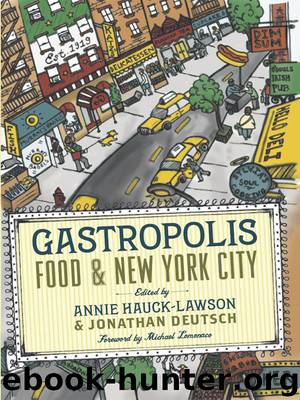Gastropolis by Annie Hauck-Lawson

Author:Annie Hauck-Lawson
Language: eng
Format: epub
Tags: Cooking/History
Publisher: Columbia University Press
Published: 2011-10-18T16:00:00+00:00
NOTES
1. Thomas F. De Voe, The Market Book: A History of the Public Markets of the City of New York (1862; repr., New York: Kelly, 1970), 15, 28–29.
2. Ibid., 31, 34, 36, 44–45, 70.
3. Ibid., 73, 77–124.
4. Ibid., 125–27, 132, 241, 242–383.
5. Ibid., 387–576.
6. Ibid., 206, 222, 425.
7. Harry Morton Goldberg, “Early History of the Markets in New York City—Continued,” East Side Chamber News, July 1929, 13; De Voe, Market Book, 532.
8. Christine Stansell, City of Women: Sex and Class in New York, 1789–1860 (Urbana: University of Illinois Press, 1987), 14.
9. Earl R. French, “Push Cart Markets in New York City: A Preliminary Report” (Washington, D.C.: Department of Agriculture, 1925), 6; New York City Department of Markets, Annual Report, 1940, 9, Markets file, Municipal Reference Library, New York.
10. Daniel Bluestone, “The Pushcart Evil,” in The Landscape of Modernity: New York City, 1900–1940, ed. David Ward and Olivier Zunz (Baltimore: Johns Hopkins University Press, 1992), 290; Harry Morton Goldberg, “What Will Become of the Curb Pushcarts?” East Side Chamber News, June 1929, 7.
11. French, “Push Cart Markets in New York City,” 4; Konrad Bercovici, “The Greatest Jewish City in the World,” The Nation, September 12, 1923, 260–61; Elizabeth Ewen, Immigrant Women in the Land of Dollars: Life and Culture on the Lower East Side, 1890–1925 (Atlantic City, N.J.: Monthly Review Press, 1985), 171.
12. Irving Howe, World of Our Fathers (New York: Harcourt Brace Jovanovitch, 1976), 77; French, “Push Cart Markets in New York City,” 26.
13. French, “Push Cart Markets in New York City,” 20, 7, 17; “Street Vendors,” in Feeding the City, box 3611, folder 6, “Street Vendors—What They Sell,” Federal Writers’ Project Papers, Municipal Archives, New York.
14. De Voe, Market Book, 501.
15. French, “Push Cart Markets in New York City,” 41–42.
16. Bernard Postal, Jewish Landmarks in New York: An Informal History and Guide (New York: Hill and Nash, 1964), 68; Olive Gunby, “The Pushcart Peddlers, the Swarms in and about Hester Street—Enormous Growth of the Trade—The Proposed Market Place—Views of a Veteran—What Some Men Have Earned—The Police and the Vendors,” New York Evening Post, August 20, 1898, in New York City Folklore: Legends, Tall Tales, Anecdotes, Stories, Sagas, Heroes and Characters, Customs, Traditions, and Sayings, ed. Benjamin Albert Botkin (New York: Random House, 1956), 204–6; French, “Push Cart Markets in New York City,” 28–29.
17. Gunby, “Pushcart Peddlers,” 204–6.
18. Anzia Yezierska, Bread Givers (New York: Venture, 1975).
19. Goldberg, “What Will Become of the Curb Pushcarts?” 7; Lillian D. Wald, The House on Henry Street (New York: Holt, 1915), 4–5; Postal, Jewish Landmarks in New York, 65–66, 64.
20. Bluestone, “Pushcart Evil,” 294; Rupert Hughes, The Real New York (New York: Hutchinson, 1906).
21. “New York Pushcart Army Exceeds 4000,” New York Daily Tribune, September 16, 1906, box 30, Lillian Wald Collection, Rare Book and Manuscript Library, Butler Library, Columbia University, New York; exhibition text and photograph list for “Hawkers and Gawk-ers: The Battle over the Pushcard Markets,” November 29, 1990, 1, Lower East Side Tenement Museum, New York.
22. Goldberg, “What Will Become of the Curb Pushcarts?” 7.
Download
This site does not store any files on its server. We only index and link to content provided by other sites. Please contact the content providers to delete copyright contents if any and email us, we'll remove relevant links or contents immediately.
| African Americans | Civil War |
| Colonial Period | Immigrants |
| Revolution & Founding | State & Local |
Cat's cradle by Kurt Vonnegut(15257)
Pimp by Iceberg Slim(14433)
4 3 2 1: A Novel by Paul Auster(12329)
Underground: A Human History of the Worlds Beneath Our Feet by Will Hunt(12052)
The Radium Girls by Kate Moore(11970)
Wiseguy by Nicholas Pileggi(5707)
The Fire Next Time by James Baldwin(5380)
Perfect Rhythm by Jae(5354)
American History Stories, Volume III (Yesterday's Classics) by Pratt Mara L(5274)
Paper Towns by Green John(5136)
Pale Blue Dot by Carl Sagan(4953)
A Higher Loyalty: Truth, Lies, and Leadership by James Comey(4905)
The Mayflower and the Pilgrims' New World by Nathaniel Philbrick(4458)
The Doomsday Machine by Daniel Ellsberg(4449)
Killers of the Flower Moon: The Osage Murders and the Birth of the FBI by David Grann(4409)
The Sympathizer by Viet Thanh Nguyen(4338)
Too Much and Not the Mood by Durga Chew-Bose(4302)
The Borden Murders by Sarah Miller(4276)
Sticky Fingers by Joe Hagan(4143)
